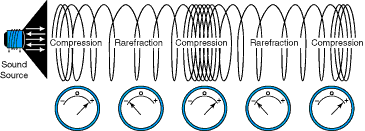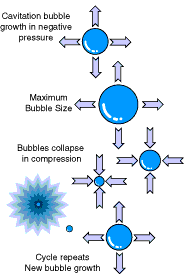Ultrasound
Audible sound has a frequency of between 10 and 18 kHz, but this is generally of too low an energy to have any influence on chemical reactivity. However, ultrasound with a wavelength of between 25 kHz and 2 Mhz has been shown to have a remarkable effect on many physical and chemical processes.
Ultrasound is a sound with a pitch so high that it can not be heard by the human ear. Frequencies above 18 Kilohertz are usually considered to be ultrasonic. The frequencies used for ultrasonic cleaning range from 20,000 cycles per second or kilohertz (kHz) to over 100,000 kHz. The most commonly used frequencies for industrial cleaning are those between 20 kHz and 50kHz. Frequencies above 50kHz are more commonly used for high precision cleaning, removal of small particles and delicate parts.
| Fig 13- the compression and expansion cycle of ultrasound |  |

  |
Cavitation and Implosion In elastic media such as air and most solids, there is a continuous transition as a sound wave is transmitted. In non-elastic media such as water and most liquids, there is continuous transition as long as the amplitude or "loudness" of the sound is relatively low. As amplitude is increased, however, the magnitude of the negative pressure in the areas of rarefaction eventually becomes sufficient to cause the liquid to fracture because of the negative pressure, causing a phenomenon known as cavitation. Cavitation "bubbles" are created at sites of rarefaction as the liquid fractures or tears because of the negative pressure of the sound wave in the liquid. As the wave fronts pass, the cavitation "bubbles" oscillate under the influence of positive pressure, eventually growing to an unstable size. Finally, the violent collapse of the cavitation "bubbles" results in implosions, which cause shock waves to be radiated from the sites of the collapse. The collapse and implosion of myriad cavitation "bubbles" throughout an ultrasonically activated liquid result in the effect commonly associated with ultrasonics. |
Pictures from
